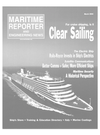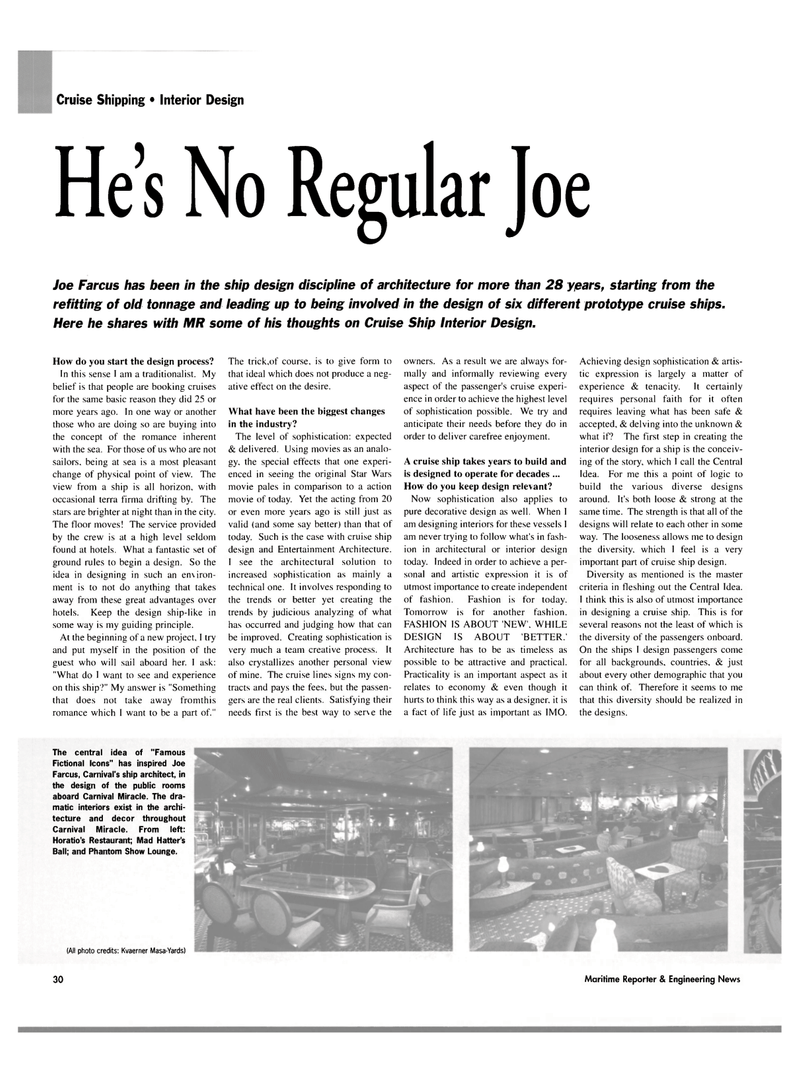
Page 30: of Maritime Reporter Magazine (March 2004)
The Cruise Shipping Edition
Read this page in Pdf, Flash or Html5 edition of March 2004 Maritime Reporter Magazine
Cruise Shipping • Interior Design
He's No Regular Joe
Joe Farcus has been in the ship design discipline of architecture for more than 28 years, starting from the refitting of old tonnage and leading up to being involved in the design of six different prototype cruise ships.
Here he shares with MR some of his thoughts on Cruise Ship Interior Design.
How do you start the design process?
In this sense I am a traditionalist. My belief is that people are booking cruises for the same basic reason they did 25 or more years ago. In one way or another those who are doing so are buying into the concept of the romance inherent with the sea. For those of us who are not sailors, being at sea is a most pleasant change of physical point of view. The view from a ship is all horizon, with occasional terra firma drifting by. The stars are brighter at night than in the city.
The floor moves! The service provided by the crew is at a high level seldom found at hotels. What a fantastic set of ground rules to begin a design. So the idea in designing in such an environ- ment is to not do anything that takes away from these great advantages over hotels. Keep the design ship-like in some way is my guiding principle.
At the beginning of a new project, I try and put myself in the position of the guest who will sail aboard her. I ask: "What do I want to see and experience on this ship?" My answer is "Something that does not take away fromthis romance which 1 want to be a part of."
The trick,of course, is to give form to that ideal which does not produce a neg- ative effect on the desire.
What have been the biggest changes in the industry?
The level of sophistication: expected & delivered. Using movies as an analo- gy. the special effects that one experi- enced in seeing the original Star Wars movie pales in comparison to a action movie of today. Yet the acting from 20 or even more years ago is still just as valid (and some say better) than that of today. Such is the case with cruise ship design and Entertainment Architecture.
I see the architectural solution to increased sophistication as mainly a technical one. It involves responding to the trends or better yet creating the trends by judicious analyzing of what has occurred and judging how that can be improved. Creating sophistication is very much a team creative process. It also crystallizes another personal view of mine. The cruise lines signs my con- tracts and pays the fees, but the passen- gers are the real clients. Satisfying their needs first is the best way to serve the owners. As a result we are always for- mally and informally reviewing every aspect of the passenger's cruise experi- ence in order to achieve the highest level of sophistication possible. We try and anticipate their needs before they do in order to deliver carefree enjoyment.
A cruise ship takes years to build and is designed to operate for decades ...
How do you keep design relevant?
Now sophistication also applies to pure decorative design as well. When I am designing interiors for these vessels I am never trying to follow what's in fash- ion in architectural or interior design today. Indeed in order to achieve a per- sonal and artistic expression it is of utmost importance to create independent of fashion. Fashion is for today.
Tomorrow is for another fashion.
FASHION IS ABOUT NEW'. WHILE
DESIGN IS ABOUT BETTER.'
Architecture has to be as timeless as possible to be attractive and practical.
Practicality is an important aspect as it relates to economy & even though it hurts to think this way as a designer, it is a fact of life just as important as IMO.
Achieving design sophistication & artis- tic expression is largely a matter of experience & tenacity. It certainly requires personal faith for it often requires leaving what has been safe & accepted, & delving into the unknown & what if? The first step in creating the interior design for a ship is the conceiv- ing of the story, which I call the Central
Idea. For me this a point of logic to build the various diverse designs around. It's both loose & strong at the same time. The strength is that all of the designs will relate to each other in some way. The looseness allows me to design the diversity, which I feel is a very important part of cruise ship design.
Diversity as mentioned is the master criteria in fleshing out the Central Idea.
I think this is also of utmost importance in designing a cruise ship. This is for several reasons not the least of which is the diversity of the passengers onboard.
On the ships I design passengers come for all backgrounds, countries, & just about every other demographic that you can think of. Therefore it seems to me that this diversity should be realized in the designs.
Maritime Reporter & Engineering News
The central idea of "Famous
Fictional Icons" has inspired Joe
Farcus, Carnival's ship architect, in the design of the public rooms aboard Carnival Miracle. The dra- matic interiors exist in the archi- tecture and decor throughout
Carnival Miracle. From left:
Horatio's Restaurant; Mad Hatter's
Ball; and Phantom Show Lounge. (All photo credits: Kvaerner Masa-Yards) 30

 29
29

 31
31
